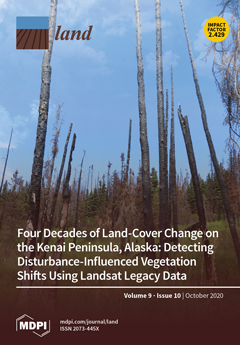Although the way in which vegetation phenology mediates the feedback of vegetation to climate systems is now well understood, the magnitude of these changes is still unknown. A thorough understanding of how the recent shift in phenology may impact on, for example, land
[...] Read more.
Although the way in which vegetation phenology mediates the feedback of vegetation to climate systems is now well understood, the magnitude of these changes is still unknown. A thorough understanding of how the recent shift in phenology may impact on, for example, land surface temperature (LST) is important. To address this knowledge gap, it is important to quantify these impacts and identify patterns from the global to the regional scale. This study examines the trend and linear regression modeling of the leaf area index (LAI) and LST derived from the moderate resolution imaging spectroradiometer (MODIS) data, specifically to assess their spatial distribution and changing trends at the continental and regional scales. The change detection analysis of interannual variability in the global LAI and LST between two periods (2003–2010 and 2011–2018) demonstrates more positive LAI trends than negative, while for LST most changes were not significant. The relationships between LAI and LST were assessed across the continents to ascertain the response of vegetation to changes in LST. The regression between LAI and LST was negative in Australia (
R2 = 0.487 ***), positive but minimal in Africa (
R2 = 0.001), positive in North America (
R2 = 0.641 ***), negative in Central America (
R2 = 0.119), positive in South America (
R2 = 0.253 *) and positive in Europe (
R2 = 0.740 ***). Medium temperatures enhance photosynthesis and lengthen the growing season in Europe. We also found a significant greening trend in China (
trendp = 0.16 ***) and India (
trendp = 0.13 ***). The relationships between LAI and LST in these most prominent greening countries of the world are
R2 = 0.06 and
R2 = 0.25 for China and India, respectively. Our deductions here are twofold—(1) In China, an insignificant association appeared between greening trend and temperature. (2) In India, the significant greening trend may be a factor in lowering temperatures. Therefore, temperature may stabilize if the greening trend continues. We attribute the trends in both countries to the different land use management and climate mitigation policies adopted by these countries.
Full article





